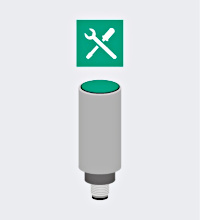Sensor Mounting

Below you will find an overview of the main points to consider when integrating inductive sensors into your applications.
Preparatory Measures
When selecting a sensor, first determine the industry type and application areas in which the sensor will be used.
It is important to select the sensor according to the installation options and the required detection range. For planning purposes, take this information into account and clarify the installation conditions. Determine the operating distances required.
It should also be specified whether the sensor can meet special conditions and, if so, what conditions. Find out which sensors are suitable for the ambient conditions of your application and find out the relevant suitability for use.
More information:
Applications and Industries
Suitability for Use
Ambient Conditions
Work Steps in Detail
The basic procedure for mounting an inductive sensor is as follows:
1. Checking and Selecting Installation Conditions
Cylindrical Sensors
The exact installation conditions for the selected sensor must be observed and followed. For cylindrical sensors, these include:
- Conditions for flush mounting
- Conditions for nonflush mounting
- Conditions for semi-flush mounting with extended operating distance
It is important to consider cross-talk when installing multiple sensors. Minimum distances between the sensors should be observed to control or eliminate cross-talk.
Cubic Sensors
Similarly, cubic sensors such as the VariKont L have precise rules for flush, nonflush, and semi-flush mounting.
As with cylindrical sensors, minimum distances must be observed between the individual sensors.
The rules are specific to the product series and are available as installation information for the selected sensor.
2. Determining/Monitoring Operating Distances with the Damping Element
Each inductive sensor has a specific detection range and a specific operating distance.
Due to the individual mounting situation in the specific application, it must be ensured that a corresponding reduction factor has been taken into account and that the sensor with the existing damping element reliably achieves the required detection range.
More information:
Determining Operating Distances with a Standard Target
3. Single-Hole Mounting or Surface Mounting of the Sensor
Cylindrical Sensors
Cylindrical sensors are small and have an external thread that allows simple and space-saving mounting of this sensor type. They are available in different diameters.
For single-hole mounting of cylindrical sensors with metal housings, the tightening torques for the external threads or the fastening screws must be observed.
The tightening torques required to mount sensors with corresponding fastening screws depend on the diameter and material of the sensors.
The following table provides an overview of conventional diameters and materials.
| Thread diameter | Stainless steel | Brass | PBT | PPS |
|---|---|---|---|---|
| M5 x 0.5 | 3.0 | - | - | - |
| M8 x 1 | 10.0 | 3.0 | - | - |
| M12 x 1 | 15.0 | 10.0 | 0.75 | - |
| M18 x 1 | 30.0 | 30.0 | 1.5 | 5 |
| M30 x 1.5 | 30.0 | 30.0 | 3.0 | 10 |
Tightening torques [Nm]
Cubic Sensors
Cubic sensors or flat packs are designed such that they can be easily and quickly mounted on surfaces at the required location. Depending on the housing design, they have one or more mounting holes with threads for fastening with corresponding screws.
4. Connection to Voltage Supply and Control Inputs
The exact way in which power is supplied depends on the particular selected sensor. The connection options vary depending on the type of connection. Accordingly, the information relating to the particular connection type must be observed.
More information:
5. Checking the Operating State and Switch State
Finally, the operating state and switch state of the sensor with damping element and built-in LED indicator(s) must be checked.
Note: Additional sensors can be added to the application at any time. The minimum distances between the individual sensors must be observed.
Links to the note:









 +1 330 425-3555
+1 330 425-3555